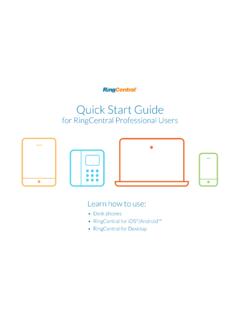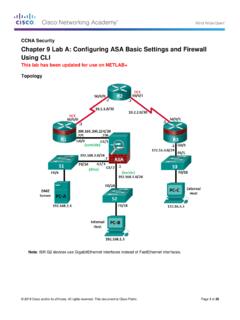Transcription of Basic Router Configuration - Cisco
1 CHAPTER 1-1 Cisco 850 Series and Cisco 870 Series Access Routers Software Configuration GuideOL-5332-01 1 Basic Router ConfigurationThis chapter provides procedures for configuring the Basic parameters of your Cisco Router , including global parameter settings, routing protocols, interfaces, and command-line access. It also describes the default Configuration on Router models may not support every feature described throughout this guide . Features not supported by a particular Router are indicated whenever chapter contains the following sections: Interface Port Labels Viewing the Default Configuration Information Needed for Configuration Configuring Basic Parameters Configuring Static Routes Configuring Dynamic Routes Configuring Enhanced IGRPEach section includes a Configuration example and verification steps, as complete information on how to access global Configuration mode, see the Entering Global Configuration Mode section in Appendix A, Cisco IOS Basic Skills.
2 For more information on the commands used in the following tables, see the Cisco IOS Release documentation Port LabelsTable 1-1 lists the interfaces supported for each Router and their associated port labels on the 1-1 Supported Interfaces and Associated Port Labels by Cisco RouterRouterInterfacePort LabelCisco 851 Fast Ethernet LAN LAN (top), FE0 FE3 (bottom)Fast Ethernet WANWAN (top), FE4 (bottom)Wireless LAN(no label) 1-2 Cisco 850 Series and Cisco 870 Series Access Routers Software Configuration GuideOL-5332-01 Chapter 1 Basic Router Configuration Viewing the Default ConfigurationViewing the Default ConfigurationWhen you first boot up your Cisco Router , some Basic Configuration has already been performed.
3 All of the LAN and WAN interfaces have been created, console and VTY ports are configured, and the inside interface for Network Address Translation has been assigned. Use the show running-config command to view the initial Configuration , as shown in Example 1-1 Cisco 851 Default Configuration on StartupRouter# show running-configBuilding Configuration : 1090 bytes!version service padservice timestamps debug datetime msecservice timestamps log datetime msecno service password-encryption!hostname Router !boot-start-markerboot-end-marker! Cisco 871 Fast Ethernet LAN FE0 FE3 Fast Ethernet WANFE4 Wireless LANLEFT, RIGHT/PRIMARYUSB1 0 Cisco 857 Fast Ethernet LAN LAN (top), FE0 FE3 (bottom)ATM WANADSLoPOTSW ireless LAN(no label) Cisco 876 Fast Ethernet LAN LAN (top), FE0 FE3 (bottom)ATM WANADSLoISDNW ireless LANLEFT, RIGHT/PRIMARYBRIISDN S/TCisco 877 Fast Ethernet LAN LAN (top), FE0 FE3 (bottom)
4 ATM WANADSLoPOTSW ireless LANLEFT, RIGHT/PRIMARYC isco 878 Fast Ethernet LAN FE0 FE3 ATM LANLEFT, RIGHT/PRIMARYBRIISDN S/TTable 1-1 Supported Interfaces and Associated Port Labels by Cisco Router (continued)RouterInterfacePort Label 1-3 Cisco 850 Series and Cisco 870 Series Access Routers Software Configuration GuideOL-5332-01 Chapter 1 Basic Router Configuration Viewing the Default Configurationno aaa new-modelip subnet-zero!ip cefip ips po max-events 100no ftp-server write-enable!interface FastEthernet0 no ip address shutdown!interface FastEthernet1 no ip address shutdown!
5 Interface FastEthernet2 no ip address shutdown!interface FastEthernet3 no ip address shutdown!interface FastEthernet4 no ip address duplex auto speed auto!interface Dot11 Radio0 no ip address shutdown speed rts threshold 2312 station-role root!interface Vlan1 no ip address!ip classless!no ip http serverno ip http secure-server!control-plane!line con 0 no modem enable transport preferred all transport output allline aux 0 transport preferred all transport output allline vty 0 4 login transport preferred all transport input all transport output all!
6 End 1-4 Cisco 850 Series and Cisco 870 Series Access Routers Software Configuration GuideOL-5332-01 Chapter 1 Basic Router Configuration Information Needed for ConfigurationInformation Needed for ConfigurationYou need to gather some or all of the following information, depending on your planned network scenario, prior to configuring your network If you are setting up an Internet connection, gather the following information: Point-to-Point Protocol (PPP) client name that is assigned as your login name PPP authentication type: Challenge Handshake Authentication Protocol (CHAP) or Password Authentication Protocol (PAP) PPP password to access your Internet service provider (ISP) account DNS server IP address and default gateways If you are setting up a connection to a corporate network, you and the network administrator must generate and share the following information for the WAN interfaces of the routers: PPP authentication type: CHAP or PAP PPP client name to access the Router PPP password to access the Router If you are setting up IP routing.
7 Generate the addressing scheme for your IP network. Determine the IP routing parameter information, including IP address, and ATM permanent virtual circuits (PVCs). These PVC parameters are typically virtual path identifier (VPI), virtual circuit identifier (VCI), and traffic shaping parameters. Determine the number of PVCs that your service provider has given you, along with their VPIs and VCIs. For each PVC determine the type of AAL5 encapsulation supported. It can be one of the following:AAL5 SNAP This can be either routed RFC 1483 or bridged RFC 1483. For routed RFC 1483, the service provider must provide you with a static IP address.
8 For bridged RFC 1483, you may use DHCP to obtain your IP address, or you may obtain a static IP address from your service PPP With this type of encapsulation, you need to determine the PPP-related Configuration items. If you plan to connect over an ADSL or line: Order the appropriate line from your public telephone service provider. For ADSL lines Ensure that the ADSL signaling type is DMT (also called ANSI ) or DMT Issue 2. For lines Verify that the line conforms to the ITU standard and supports Annex A (North America) or Annex B (Europe).Once you have collected the appropriate information, you can perform a full Configuration on your Router , beginning with the tasks in the Configuring Basic Parameters section.
9 1-5 Cisco 850 Series and Cisco 870 Series Access Routers Software Configuration GuideOL-5332-01 Chapter 1 Basic Router Configuration Configuring Basic ParametersConfiguring Basic ParametersTo configure the Router , perform one or more of these tasks: Configure Global Parameters Configure Fast Ethernet LAN Interfaces Configure WAN Interfaces Configuring a Loopback Interface Configuring Command-Line Access to the RouterA Configuration example is presented with each task to show the network Configuration following completion of that Global ParametersPerform these steps to configure selected global parameters for your Router :For complete information on the global parameter commands, see the Cisco IOS Release documentation set.
10 CommandPurposeStep 1configure terminalExample: Router > enableRouter# configure terminalRouter(config)# Enters global Configuration mode, when using the console you are connecting to the Router using a remote terminal, use the following:telnet Router name or addressLogin: login idPassword: ** Router > enableStep 2hostname nameExample: Router (config)# hostname RouterRouter(config)# Specifies the name for the 3enable secret passwordExample: Router (config)# enable secret cr1ny5hoRouter(config)# Specifies an encrypted password to prevent unauthorized access to the 4no ip domain-lookupExample: Router (config)# no ip domain-lookup Router (config)# Disables the Router from translating unfamiliar words (typos) into IP addresses.
















